
With the UEFA Euros in full flow and National Beer Day marked last week, we would like to rum you through some tips for keeping your alcohol ads in line with the Code, with the new rules for zero alcohol drinks in mind.
Alcohol section shaken and stirred - new rules on alcohol alternatives
In May a new set of rules were launched for alcohol alternatives - defined as drinks between 0.0-0.5% ABV - such as non-alcoholic beer and wine. The new rules (18.18–18.24) in Section 18 of the CAP Code, will apply to ads that specifically show alcohol-free drinks as alternatives to alcohol. However, the full alcohol rules will still apply if an ad at or below 0.5% ABV has the effect of promoting an alcoholic drink, such when a range of drinks is featured which includes alcoholic drinks too.
Ads for non-alcoholic versions of alcoholic drinks which share a brand name (or products owned by a brand known for selling alcoholic drinks), will not be considered to inherently promote their alcoholic counterparts. However, such advertising must make clear the alcohol-free nature of the alternative product, as well as feature a prominent statement of the product’s ABV.
Read more: CAP’s Advertising Guidance for Alcohol Alternatives and Alcohol alternatives.
Handle the use of influencers with care
The new rules for alcohol alternatives mirror the targeting rules for standard alcoholic drinks. The rules for both products set out that ads must not be likely to appeal particularly to people under 18 or feature any real or fictitious characters with particular appeal. Plus, ads for alcohol and alcohol alternatives should not be directed at children through the selection of media they appear in, and no more than 25% of an audience should be children.
Marketers should treat the use of influencers with caution and consider carefully if ads are appropriately targeted to ensure children are not overrepresented in audiences. The ASA upheld a complaint against a TikTok post for alcoholic drinks by a Love Island presenter, as they considered a large proportion of under 18s were likely to interact with Love Island content on the platform, and even if they did not follow the presenter, children were likely to have seen the ad via algorithm.
Marketers must also not use any influencer, celebrity or other person who is (or seems to be) under the age of 25 to promote their alcohol or alcohol-free products. An ad for an alcohol brand featuring rapper ArrDee breached the Code because he was 20 years old at the time it appeared, and the ASA considered the phrase "#GETLIT" was likely to encourage excessive consumption of alcohol.
Read more: Alcohol: Targeting and Appeal to Under 18s and Alcohol: Use of celebrities and influencers.
Steer clear of linking alcohol with driving
Advertisers should take care to avoid linking alcohol with driving or the use of potentially dangerous machinery, or with activities or locations in which drinking would be unsafe or unwise.
Even when they have not been promoting alcohol or cars, ads have fallen foul of the Code if they have linked alcohol with driving, such as this ad for a track by a record label, in which alcohol appeared to be handed to people in a car.
The ASA recently ruled against an ad showing a man driving in a racing car simulator game, alongside the claim “drink driver package”. They considered the ad, for gaming party packages with beer and prosecco, had not made clear the simulator was a videogame rather than a car, and trivialised and encouraged drink driving.
Marketers should also be cautious of reposting or engaging with user-generated social media posts featuring alcohol, as this can bring the content into remit of the CAP Code. A user-generated tweet featuring an image of alcoholic drinks inside a car that had been reposted by a vodka brand, was also banned in 2023.
Be a stranger to danger – avoid unwise locations and activities
In terms of unwise locations, the ASA has upheld complaints against ads featuring alcohol in work places, such as this ad showing a bottle of whiskey alongside a mechanic in a garage. Another ad that depicted mountaineers pouring whiskey while climbing in snowy and challenging terrain, an unwise activity, was also banned. Although ads for alcohol can feature sporting or physical activities, they should not suggest alcohol was consumed beforehand.
But on the other hand, the new rules do permit ads to feature alcohol alternatives in contexts where drinking alcohol would be inappropriate or unsafe, such as before driving or daring physical activities, providing the ad makes clear the product is an alcohol alternative.
Read more: Alcohol: Unwise locations and activities and Safety.
There’s much more on the alcohol rules in CAP’s Alcohol: General guidance. And, if you’re not sure whether your non-broadcast ads stick to the rules, the CAP Copy Advice team are always on hand to provide free bespoke advice.
More on
-
Keep up to date
Sign up to our rulings, newsletters and emargoed access for Press. Subscribe now.


